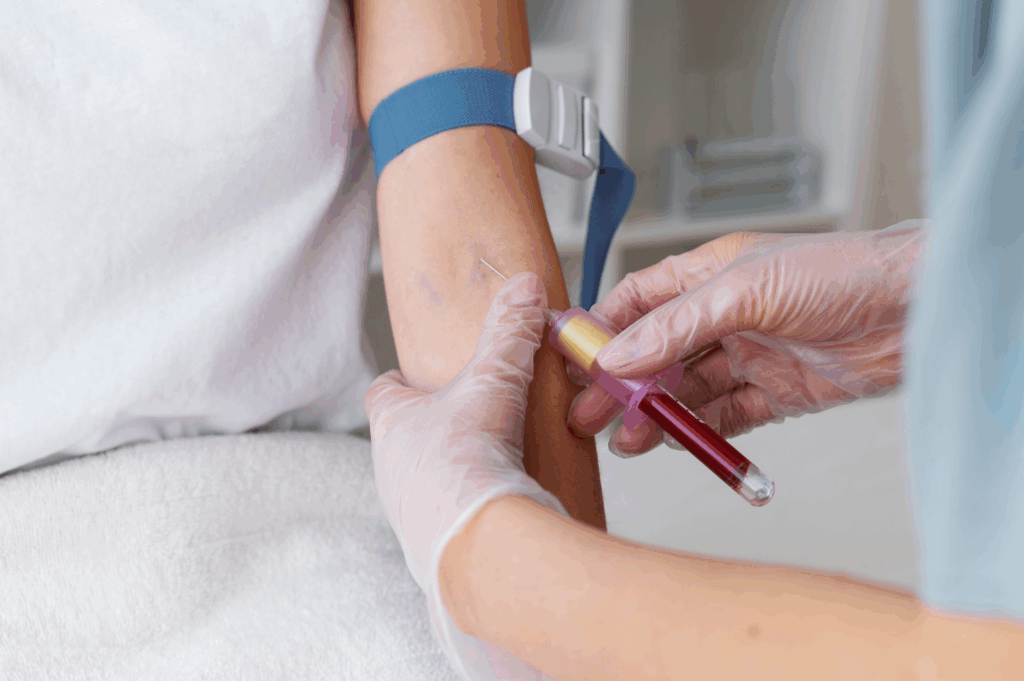Understanding glycated hemoglobin meaning is essential for keeping tabs on diabetes. HbA1c, another name for glycated hemoglobin, gives us a picture of your average blood sugar levels over the last two to three months. This helps in managing diabetes effectively. In the past, doctors watched blood sugar levels closely, but now, the focus has shifted to the long-term tracking offered by HbA1c tests. This change has been a game-changer for diabetes care, putting the spotlight on how minor changes in lifestyle and treatment affects long-term health.
Importance of HbA1c in Diabetes Management
HbA1c is a crucial part of managing diabetes. It links closely to how well you control your condition and how likely you are to face complications. This test shows a bigger picture, confirming how well your body is managing glucose, more than just showing day-to-day changes in blood sugar.
Unlike the rapid shifts that happen throughout the day, glycated hemoglobin means you’re gaining insights into long-term trends. It helps predict future complications. The higher the numbers, the greater the risks. Monitoring this can motivate changes in diet, exercise, or medication. Glycated hemoglobin high means increasing risks for diabetes complications, making it urgent to focus on lowering levels. Thus, it’s not merely a figure on a report but a crucial indicator for long-term health.
Interpreting HbA1c Test Results: A Patient’s Guide
Getting an HbA1c test is simple. No need to fast before the test. Go during a regular health check. Results tell how well you’ve managed diabetes over the last few months.
When reading the results, remember
- A normal HbA1c level is below 5.7%.
- Prediabetes ranges from 5.7% to 6.4%.
- Diabetes hits at 6.5% or higher.
Understanding these numbers helps you make better health decisions, pushing for improved care strategies that can involve diet and lifestyle tweaks. A glycosylated Hb means these lifestyle choices are crucial in enhancing health.
HbA1c’s Role in Sustaining Long-Term Health
HbA1c is a window into the steadiness of glucose control across weeks and months, showing overall diabetes management. The benefits of keeping HbA1c within optimal levels span years, reducing risks of complications like heart disease and kidney problems.
By continually monitoring your HbA1c, you maintain better control over your health. This vigilance results in more stable blood sugar levels, helping stave off harm. Glycated hemoglobin high only means more effort is needed for balanced glucose. This insight moves the scope from immediate issues to a broader health outlook, stressing the importance of unwavering attention to monitoring.
Practical Lifestyle Adjustments for Better HbA1c Management
Making small changes in daily habits significantly impacts HbA1c levels. Here’s how:
- Diet: Eat more fiber-rich foods like fruits, vegetables, and whole grains to maintain steady blood sugar levels.
- Exercise: Engage in regular activities like walking or yoga. This improves insulin sensitivity, which helps in controlling glucose levels.
- Mental Health: Managing stress through meditation or hobbies aids in keeping blood sugar stable since stress can raise glucose.
Utilize local resources in India, like nutritionists or diabetes centers, for tailored guidance. By maintaining an active lifestyle, and being mindful of diet, glycosylated hemoglobin definition shows that you can effectively influence your health outcomes.
Clarifying Misunderstandings About HbA1c
Sometimes people misunderstand the HbA1c test, thinking it’s just another routine check. But this test offers comprehensive insight into long-term health. Misinterpretation can lead to neglect or improper diabetes management.
Regular testing and understanding what glycosylated hemoglobin high means is vital, ensuring you keep health risks at bay. With the correct information, you make smarter health choices, leading to a more balanced life.
Innovations in HbA1c Testing Accessibility in India
Access to affordable and innovative HbA1c testing is growing in India.
- Many clinics offer cost-effective testing options.
- Mobile healthcare initiatives bring tests to remote areas, expanding care reach.
Community-based projects aim to increase the availability and understanding of such tests. These initiatives are crucial for ensuring more people access the benefits of effective management through regular monitoring.
Personal Stories: The Impact of HbA1c Awareness on Diabetes Management
Across India, individuals have turned their lives around by understanding glycated hemoglobin meaning. Knowing how glycosylated hemoglobin definition applies to their lives has led to better management.
Real stories show the power of knowledge in maintaining normal HbA1c levels. By making small, impactful changes, individuals control diabetes better, enhancing overall life quality. Sharing these experiences empowers others on similar journeys.
Partnering with Healthcare Providers for Optimal Diabetes Care
Discussing HbA1c readings with your healthcare provider is vital. In India, doctors personalize treatment plans using this data, making adjustments based on your history and lifestyle.
This teamwork results in tailored care and more effective diabetes management. Establishing strong communication and regular check-ins with your healthcare team ensures better outcomes.
Conclusion: Owning Your Health with Knowledge and Actions
Understanding the glycated hemoglobin meaning is a critical part of managing health. Active patient involvement through education and lifestyle adjustments drives improvements.
Stay engaged with your healthcare journey, ensuring that regular monitoring and collaboration with providers lead to meaningful changes. Future advances promise to expand educational outreach, increasing awareness and fostering healthier communities.

